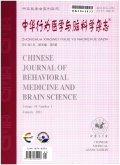主观认知下降人群动态低频振幅与空间导航障碍相关性的功能磁共振成像研究
A functional magnetic resonance imaging study on correlation between dynamic amplitude of low frequency fluctuation and spatial navigation impairment in individuals with subjective cognitive decline
摘要目的:探究主观认知下降(subjective cognitive decline,SCD)人群动态自发性脑活动改变,及其与空间导航功能的相关性。方法:招募2020年9月至2023年2月期间在南京大学医学院附属鼓楼医院就诊的SCD人群(SCD组, n=72),以及年龄、性别和教育程度相匹配的正常对照(NC组, n=67),所有被试均接受静息状态功能磁共振成像(resting-state functional magnetic resonance imaging,rs-fMRI)检查、空间导航行为学测试和认知功能评估。利用滑动时间窗口方法分割rs-fMRI时间序列。采用SPSS 26.0软件进行统计分析,比较两组间动态低频振幅(dynamic amplitude of low frequency fluctuation,dALFF)差异,将差异脑区的dALFF值与量表评分、空间导航测试进行相关性分析。 结果:与NC组相比,SCD组在右侧楔前叶(0.119±0.021,0.130±0.031)、左侧楔叶(0.143±0.034,0.156±0.032)dALFF变异性减低( t=-3.41,-3.12, P<0.05,FDR校正),在右侧枕中回(0.146±0.023,0.137±0.020)、右侧角回(0.148±0.025,0.139±0.026) dALFF变异性升高( t=4.51,3.36,均 P<0.05,FDR校正);SCD组右侧楔前叶dALFF变异性与自我空间导航误差( r=-0.341, P=0.025)、延迟空间导航误差( r=-0.286, P=0.035)及记忆功能( r=-0.332, P=0.009)呈显著负相关,左侧枕中回dALFF变异性与语言功能( r=0.339, P=0.015)、视空间功能( r=0.343, P=0.008)呈显著正相关。 结论:右侧楔前叶、左侧枕中回dALFF变异性异常改变可能是SCD人群早期认知减退、空间导航障碍的神经机制,可作为早期识别SCD人群潜在的影像标志物。
更多相关知识
abstractsObjective:To explore the differences in dynamic spontaneous brain activity in individuals with subjective cognitive decline (SCD) and its correlation with spatial navigation ability in SCD subjects.Methods:A total of 72 SCD subjects(SCD group) and 67 normal controls (NC group) matched for age, gender and education level were recruited from September 2020 to February 2023 at the Affiliated Drum Tower Hospital, Medical School of Nanjing University. All participants underwent resting-state functional magnetic resonance imaging (rs-fMRI) examinations, spatial navigation tests and cognitive function assessments. The rs-fMRI time series were segmented using a sliding time window method, and statistical analyses were carried out using SPSS 26.0 software to compare the differences in the dynamic amplitude of low frequency fluctuation (dALFF) between the two groups. Correlation analysis was conducted between dALFF values in different brain regions and scale scores and spatial navigation tests.Results:Compared with the NC group, the dALFF variability in the right precuneus(0.119±0.021, 0.130±0.031) and left cuneus(0.143±0.034, 0.156±0.032) in SCD group decreased ( t=-3.41, -3.12, P<0.05, FDR corrected), and the dALFF variability in the right middle occipital gyrus(0.146±0.023, 0.137±0.020) and right angular gyrus(0.148±0.025, 0.139±0.026) increased ( t=4.51, 3.36, both P<0.05, FDR corrected). The temporal variability of dALFF in the right precuneus in SCD group was negatively correlated with egocentric spatial navigation ( r=-0.341, P=0.025), delayed allocentric spatial navigation ( r=-0.286, P=0.035) and memory function ( r=-0.332, P=0.009). The temporal variability of dALFF in the left middle occipital gyrus was positively correlated with language function ( r=0.339, P=0.015) and visuospatial function ( r=0.343, P=0.008) in SCD group. Conclusions:The temporal variability of dALFF in the right precuneus and the left middle occipital gyrus may be the neurobiological basis of cognitive decline and spatial navigation impairment in SCD subjects, and it can be used as a potential imaging marker for early identification of SCD patients.
More相关知识
- 浏览0
- 被引0
- 下载0


相似文献
- 中文期刊
- 外文期刊
- 学位论文
- 会议论文



 换一批
换一批 换一批
换一批



